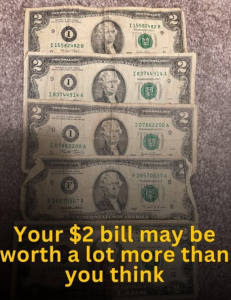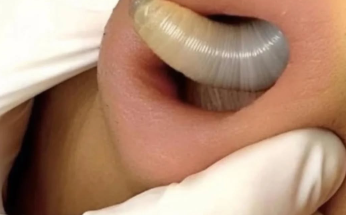
Got $2 Bills? They May Be Worth More Than You Think!
At first glance, a $2 bill might seem like an oddity—something rare, maybe even obsolete. You might have found one tucked in an old birthday card or slipped into a drawer by a grandparent. Most people assume these bills are worth, well, exactly $2. But in the world of currency collecting, also known as numismatics, some $2 bills can actually be worth hundreds or even thousands of dollars depending on their condition, rarity, and specific features. Here’s everything you need to know about the surprising value of $2 bills.
A Brief History of the $2 Bill
The $2 bill has a long and winding history in the United States. It was first issued in 1862, during the Civil War, and featured Alexander Hamilton. Later, in 1869, Thomas Jefferson became the face of the note—a role he continues to play on $2 bills today.
Despite its lengthy history, the $2 bill never became as popular or widely used as other denominations like the $1 or $5 bill. Part of this stems from its association with gambling, bribes, and even superstition. For many Americans, receiving a $2 bill feels strange or even lucky—and that perception has only grown as fewer and fewer are seen in circulation.
Are $2 Bills Still Being Made?
Yes! Contrary to popular belief, $2 bills are still printed by the Bureau of Engraving and Printing, although not nearly as frequently as other bills. The most recent printing was in 2022, when over 100 million $2 notes were produced. They are legal tender and can be spent anywhere, just like any other bill. However, because people don’t often see them, $2 bills tend to be hoarded or mistaken for rare currency, even when they’re not.
What Makes a $2 Bill Valuable?
Not all $2 bills are worth more than their face value, but several factors can boost their market price:
1. Date and Series
Older $2 bills, particularly those issued before 1928, can be extremely valuable. These large-size notes are bigger than today’s standard currency and often feature different designs and red seals.
For example:
-
A 1917 $2 Legal Tender Note in good condition could be worth $100–$500 or more.
-
A 1928 red seal $2 bill may fetch anywhere from $10 to over $300, depending on its condition and serial number.
2. Star Notes
If your $2 bill has a star symbol next to the serial number, that’s a replacement note. These are printed to replace misprinted or damaged bills and are produced in smaller quantities, making them more valuable to collectors. A star note from 1976, for instance, might sell for $20–$50, while rare star notes from earlier series can go for hundreds.
3. Low Serial Numbers
Bills with low serial numbers (like 00000001 to 00000099) or repeating patterns (like 12344321, 22222222, etc.) are highly collectible. A $2 bill with a serial number of 00000001 could be worth $1,000 or more, depending on its condition and series.
4. Unique Errors
Printing errors—misalignments, ink smears, or doubled serial numbers—can significantly increase a bill’s value. Error notes are rare and can sell for hundreds or thousands depending on how noticeable the error is.
5. Uncirculated Condition
Uncirculated bills—those that have never been folded, creased, or used—are worth more than those that have seen everyday use. A pristine, uncirculated $2 bill from 1976 might only be worth $5–$15, but if it’s older or has a unique serial number, its value could soar.
The 1976 Series – The Most Common “Collectible”
The 1976 $2 bill is probably the most widely saved version of the note. That year marked the United States’ bicentennial, and the government reintroduced the $2 bill with a new reverse design featuring the signing of the Declaration of Independence (a reproduction of John Trumbull’s painting).
Many people saved these as commemorative items, meaning millions remain in excellent condition. Because of this, most 1976 $2 bills—even in uncirculated condition—are only worth a few dollars more than face value unless they have other distinguishing features.
Modern $2 Bills (1995, 2003, 2009, 2013, 2017, 2022)
Recent series of $2 bills are still actively used and can be ordered directly from some banks—although most people never think to ask. These notes typically have green seals and are rarely worth more than $2 unless they are:
-
Star notes
-
Have fancy serial numbers
-
Are part of limited-run printings
How to Check If Your $2 Bill Is Worth More
Here’s a quick checklist you can use to assess your $2 bill:
-
Look at the date and series. Is it before 1928? If yes, it might be valuable.
-
Check the seal color. Red seals are older and more collectible than green ones.
-
Inspect the serial number. Look for stars, repeating digits, or low numbers.
-
Assess the condition. Crisp, uncirculated bills are always worth more.
-
Look for errors. Misprints or anomalies can raise value drastically.
If you’re unsure, consider consulting a currency appraisal expert or checking websites like to compare listings.
Where to Sell Valuable $2 Bills
If you think you’ve struck gold with a rare $2 bill, you have several selling options:
-
eBay – A common marketplace for buying and selling collectible currency.
-
Numismatic dealers – They can give you a professional appraisal and offer a fair price.
-
Currency shows and conventions – Great for meeting collectors and enthusiasts.
-
Online auction houses – Websites like Heritage Auctions can attract serious bidders.
Always research before selling—what looks ordinary to you might be extraordinary to a collector.
Bottom Line: Don’t Dismiss That $2 Bill
Most $2 bills are worth exactly what they say—two dollars. But every once in a while, you might stumble on a note that’s worth far more. Whether it’s a forgotten heirloom in your drawer or a surprise find in your wallet, it’s worth taking a second look.
